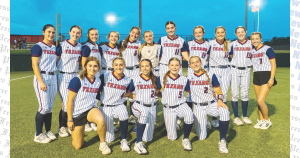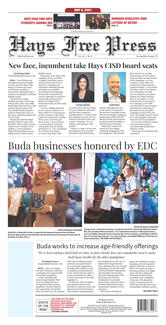
HAYS COUNTY — Each year, up to one billion birds fatally crash into windows as they migrate across the United States. The local community has the power to greatly reduce this number by turning off nonessential lights.
LIGHTS OUT, TEXAS!
HAYS COUNTY — Each year, up to one billion birds fatally crash into windows as they migrate across the United States. The local community has the power to greatly reduce this number by turning off non-essential lights.
With only one month into the spring migration season, more than 20 million birds have already crossed through Hays County. Audubon Texas, the state branch of the National Audubon Society dedicated to conserving and restoring natural ecosystems, launched its Lights Out, Texas! campaign in 2017.
Chloe Crumley, Audubon Texas’ public affairs and engagement manager, explained that the purpose of the campaign is to protect migratory birds as they travel through the state during the spring and fall seasons — March 1 through June 15 and Aug. 15 through Nov. 30, respectively.
According to Crumley, Texas lies in the “central flyway.” Each spring and fall, one in three birds that migrate across the United States fly through Texas.
“We see a billion birds which is pretty unique and rare,” Crumley said. “Texas itself has over 600 species that you can find here. We’re really a mecca and a hub for migratory birds.”
Birds migrate at night when wind conditions are smoother and the stars and moon can help guide their way, Crumley said. However, as they reach cities with towering downtown skyscrapers and residential areas full of outdoor lights, this can attract and confuse them.
“One of the things that unfortunately happens to them is that excessive lighting at night and light pollution can disorient them,” Crumley said. “Oftentimes, they’ll get confused and end up flying around and calling out and they’ll land in a community [where they] face other urban threats like cats or toxic materials. Not all of them will make it to their end destination [and] these birds have traveled thousands and thousands of miles.”
Lights Out, Texas! is working to educate the public on what they can do to help birds safely migrate through the state and while Crumley said it has been a “journey,” residents doing their part is actually relatively simple — it’s not just about turning off lights in big buildings.
A 2021 National Academy of Sciences peer review study that covered two decades worth of data showed that turning off downtown lighting reduced bird fatalities by about 50%, but that lighting going off anywhere including residential areas also had a positive impact.
Turning off non-essential lights from 11 p.m. to 6 a.m. including porch lights and landscape lighting like tree spotlights, and closing blinds (even at night, as indoor lights with the blinds open can create distracting light and tree reflections) top the list of ways residents can help birds safely migrate.
“You’re going to bed and are no longer going to appreciate [the lighting],” Crumley said. “Our birds that stop over and want a place to rest at night do appreciate you turning your lights off, just like you do when you sleep. Birds would like to see the same consideration.”
Providing a source of clean water should birds stop over and ensuring that your pets are inside also helps. Crumley also encouraged residents to get into the habit of practicing “good lighting” year-round, not just twice a year during bird migration. This is important from an energy conservation and light pollution standpoint, she added. Motion sensors, timed lights and warm-colored, low-light lightbulbs are also options.
“We’re really just trying to educate people and are looking to the public to help us communicate the value and the need to turn lights out and non-essential lighting in our downtown areas,” Crumley said. “We want residents to call their city council person, call their county commissioner, call the mayor. Let them know about Lights Out, Texas! and that it’s important to remind them that we don’t need to keep the buildings lit up at night.”
Many in the local community have stepped up. One city in Hays County is even home to a Bird City Texas recognition — an Audubon Texas and Texas Parks and Wildlife Department certification for communities that are heavily involved in protecting bird habitats and creating safe spaces for them. Dripping Springs received the certification in February 2022 and is one of only 10 Bird Cities in the state.
On top of the positive environmental impacts birds bring, Texas sees about 2.2 million birders who contribute $1.8 billion to the state’s wildlife viewing economy.
“Texas is an incredibly diverse space for ecosystems and wildlife,” Crumley said. “It is an amazing opportunity for us to see so many different migratory birds in our state. I tell people to put out a bird feeder and see what they can spot during this migratory season. Being a ‘backyard birder’ is a good way to experience something unique that our state has.”
Peak migration season begins April 22 and will last through May 12. For more information, visit tx.audubon.org/urbanconservation/lights-out-texas or www.txnsf.org/lights-out-hays to see local efforts in Hays County. A bird migration tracker is also available to view at birdcast.info.














